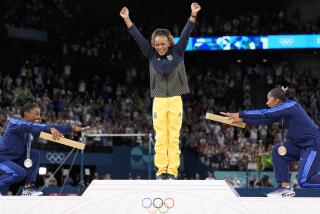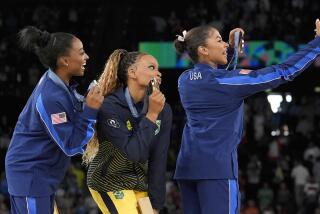London Olympics hopeful Carmelita Jeter a worker in progress
- Share via
Carmelita Jeter makes a simple request.
She is 32 and runs really fast, so fast that she had a 100-meter time of 10.64 seconds in China in 2009.
Only Florence Griffith Joyner, who had a 10.49 run at the 1988 U.S. Olympic trials, has been faster, and that time remains the world record. But Flo-Jo, died at age 38 and though there was no evidence of it, everybody has always wondered. Had Flo-Jo used illegal substances to make her body jet-powered?
Jeter too hears the questions. She didn’t begin earning her best times until after the 2008 Olympics, for which she failed to qualify. She will try begin another Olympic quest in Eugene, Ore., at Olympic trials this month. The first women’s 100-meter qualifying heats are on June 22.
After the 2008 Games, Jeter changed coaches and began working with John Smith, who has also coached Maurice Greene, who was suspected of using illegal performance-enhancing drugs though he never failed a test or was suspended.
Jeter, from Los Angeles all the way — Bishop Montgomery High, Cal State Dominguez Hills — has close-cropped hair, barely noticeable earrings and electric-pink shoes on a Tuesday morning when she arrives at the track at West Los Angeles College that Smith uses as his practice place.
She digests the question. What do you tell people who question your performance over the past four years, who whisper it can’t be real, that it must be drug-aided.
Jeter looks you straight in the eye.
“I tell them and I tell you, watch me practice.”
And for nearly five hours on the day after Memorial Day, Jeter runs a series of dashes, 60, 70 yards, in bunches. Five, six, seven times in a row, and all you hear is the sound of a starter’s whistle, interval times screamed out through a bullhorn and the word “Again.”
At various times you see Jeter sprawled, face down in a patch of dirt off the track or bent over searching for air or sitting with her head between her knees.
What you don’t see or hear is Jeter complain or curse or ask to stop or whine about whether practice is over. She just keeps going.
Ralph Mann, once a world-class track athlete and now a specialist in sport biomechanics, says Jeter is the toughest athlete he has ever met.
“I’ve worked with golfers, football players, you name it,” Mann says. “She works harder than them all.”
Mann has created a computer program, CompuSport. The program creates a digital image of an athlete, a stick-figure Jeter, for example, and makes that stick figure run whatever time he wants. Like, say, a world record. Then he would superimpose that figure with another Jeter, a real-time Jeter, taken with a camera on the track. Frame by frame, Mann and Smith can watch the two Jeters and explain to the live one every place she can pick up fractions of seconds.
The real Jeter is 5 feet 4 inches tall, according to the measurements taken to make her computer figure. She has a 10-inch upper arm and a 10-inch lower arm. Her body weight is 132 pounds. Her waist is 25 inches around, her upper leg 14.50 inches, her lower leg 17.00 inches. That is ideal for a sprinter Mann says, a lower leg so much longer than an upper leg.
None of those numbers matter to Jeter. Only the clock matters.
And when she was growing up, the clock didn’t matter either.
Jeter was a basketball player first. Her brother, Pooh Jeter, played in the NBA and when Carmelita Jeter watched the Olympics she wanted to be Sheryl Swoopes, winning gold for the U.S. and then playing professionally.
But she also ran fast and in high school her coaches prodded her about getting serious on the track, and Jeter found herself another athletic hero: hurdler Gail Devers. Jeter would never find peace with the hurdles: “It hurts when you knock into them,” she says, but her sports career path permanently changed. She would become a sprinter.
By the 2008 Olympic trials, it was assumed Jeter was a lock for the team. A year before she won a bronze medal in the 100 at the world championships and finished the season at the World Athletics final with a gold.
Jeter admits her breakthrough 2007 season resulted in a desultory 2008.
“I got overconfident and lax and I didn’t come into 2008 with the edge I had in 2007,” she said. “I got the medal in 2007 and acted like I accomplished something when, really, I didn’t do much.
“I can’t blame anybody but myself for not qualifying at the U.S. [Olympic] trials in 2008. The reality was I didn’t make the team and it happened for a lot of reasons and they were all my fault.
“But it sure hurt. I watched those Games and it hurt more every day to the point where it was time to make a change.”
Jeter called her agent, Chris Lane, and said she needed a fresh start, a new coach. Lane called Smith.
In November 2008, Jeter got her fresh start.
Smith answers the question about doping suspicions with a wave of his hand and a derogatory whistle.
“You say that, you have low esteem for the human being,” he says. “The human being is the most wonderful machine. It can adapt to anything. Why shouldn’t times be getting faster? Did we have computers 30 years ago, cellphones 20 years ago, HDTV, Internet? Everything gets faster.
“Someone comes along, breaks the mold, say, goes against the concept that you have to be 22 years old to run fast, we have hysteria and assumptions. We have faster cars, faster computers.
“I now have video and a computer that shows me instantly, in a second, where I can make corrections and in another second I can see if the body is not able to handle it. I have objective data, formulas, and I can put it on a canvas and make it come to life.
“Solving problems is what I live for. The process, that’s my love. I don’t see limits. I know and the athlete knows what’s going on. That’s all that matters.”
Jeter’s dad, Eugene, also played basketball. Her mom, Gloria, was a cheerleader. She said once upon a time she could beat Pooh in basketball and Pooh would like to set up a meeting where the two would play basketball against each other then run 100 meters.
“That might be fun,” Jeter said.
Jeter can’t describe exactly what it is that Smith has changed in her technique. “Tweaks here and there,” she says. “He has changed my attitude. He gives you belief.”
And if some want to believe Smith gives her something else, Jeter doesn’t care. “All I can do,” she says, “is keep working.”
twitter.com/mepucin
More to Read
Go beyond the scoreboard
Get the latest on L.A.'s teams in the daily Sports Report newsletter.
You may occasionally receive promotional content from the Los Angeles Times.






